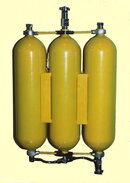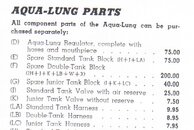Is she using the air or Nitrox version. I have actually had a customer insist I use the nitrox service kit because they wanted to use 32% to minimize nitrogen loading on a emergency assent.
You are using an out of date browser. It may not display this or other websites correctly.
You should upgrade or use an alternative browser.
You should upgrade or use an alternative browser.
Spare Air The Best Item in Your Scuba Toolbox
- Thread starter DiverWire
- Start date
Please register or login
Welcome to ScubaBoard, the world's largest scuba diving community. Registration is not required to read the forums, but we encourage you to join. Joining has its benefits and enables you to participate in the discussions.
Benefits of registering include
- Ability to post and comment on topics and discussions.
- A Free photo gallery to share your dive photos with the world.
- You can make this box go away
haha49
Contributor
At best it gives you a few extra breaths. Most of the time you can get to the surface with out much trouble you can really move when you run out of air. It's ok for people in whitewater rafting as you can flip over and at least you have something small and easy to give you a few breaths as you wait and hope the river spits you back out. At the end of the day a pony bottle is a way better option but it also costs more. How much is your life worth at the end of the day. Watch your air have a backup if needed. I dive solo and don't have a partner simply because of time ect at the end of the day it's my life and it's a risk so having a pony bottle is like having a dive buddy glued to you. I find most partners tend to wonder off or be to far away. When they're further then the surface you might as well go up it all depeneds on the depth your at. Never had to use the pony bottle but at least it's there.
diver 85
Contributor
.................AGAIN.........@ least one can die with multiple 'tanks' 'in hand'......And here we go....
---------- Post added November 27th, 2014 at 12:51 PM ----------
......This diver doesn't play with a full deck----& if you tell them to cut the cards, here comes the butcher knife---etc etc etc....Is she using the air or Nitrox version. I have actually had a customer insist I use the nitrox service kit because they wanted to use 32% to minimize nitrogen loading on a emergency assent.
Last edited:
.................AGAIN.........@ least one can die with multiple 'tanks' 'in hand'......
It's a great redundancy strategy - it's the only piece of gear that enables you to run out of air TWICE on the same dive.
I notice that comments are closed on the original posting on Diver Wire. Pity.
I suspect the comments were never open on the original posting.
Yeah but I did send an email to the poster who provided one in the article . Asked her why they were trying to kill new divers. And that the instructor who wrote the thing should be ashamed of that post.
. Asked her why they were trying to kill new divers. And that the instructor who wrote the thing should be ashamed of that post.
By the way she is also the CEO of Scuba.com. Think she has a crap load of them and wants to sell em?
scuba diving safety and training | Scuba Diving
By the way she is also the CEO of Scuba.com. Think she has a crap load of them and wants to sell em?
scuba diving safety and training | Scuba Diving
Bob DBF
Contributor
Yeah but I did send an email to the poster who provided one in the article. Asked her why they were trying to kill new divers. And that the instructor who wrote the thing should be ashamed of that post.
By the way she is also the CEO of Scuba.com. Think she has a crap load of them and wants to sell em?
scuba diving safety and training | Scuba Diving
Now if her attitude was to sell them, perhaps she would have gotten further marketing it as a fun toy.
On the site under ask the expert, was this interesting bit "Cousteau and Gagnans 1946 double-hose Aqua Lung was easy to use, reliable and safe for sport divers. There was no backup, except for a reserve valve on the cylinder (J-valve), and sport diving thrived.". Since the J-valve came out in '55, I guess proof reading suffers as well.
Bob
The spare air is an outstanding product... for well-trained helicopter crews. It would also work fine for well-trained and skilled divers who could just do a free ascent without one anyway. Unfortunately, the divers that need it most are too likely to become overly confident in it's limited capacity.
---------- Post added November 28th, 2014 at 10:00 AM ----------
It is interesting that Cousteau’s divers never used a J-valve. They actually carried a third or fourth cylinder on the manifold that stayed closed. They only had a single regulator but used a far larger and more reliable reserve than the J-valve provided.
There is another much bigger culprit at play here, modern high performance regulators. Regulators before around the mid-1980s would get noticeably more difficult to inhale at tank pressures in the 300-500 PSI range. It was a hard-to-miss signal that the dive was over and to get your butt to the surface. It was also plenty of air to get back to the surface on a typical recreational dive.
Hard to breathe is way better than almost instantly sucking a vacuum. Most regulators on the market today let you breathe a cylinder down to or below the IP pressure, which can leave only 1-3 breaths after you sense the increase. Sure you “should” be monitoring your SPG, but the penalty for getting distracted shouldn’t be death.
I often use a hybrid of Cousteau’s approach called Progressive Equalization
Here is an image of the early triple cylinder sets used by Cousteau.
---------- Post added November 28th, 2014 at 10:00 AM ----------
…On the site under ask the expert, was this interesting bit "Cousteau and Gagnan’s 1946 double-hose Aqua Lung was easy to use, reliable and safe for sport divers. There was no backup, except for a reserve valve on the cylinder (J-valve), and sport diving thrived.". Since the J-valve came out in '55, I guess proof reading suffers as well…
It is interesting that Cousteau’s divers never used a J-valve. They actually carried a third or fourth cylinder on the manifold that stayed closed. They only had a single regulator but used a far larger and more reliable reserve than the J-valve provided.
There is another much bigger culprit at play here, modern high performance regulators. Regulators before around the mid-1980s would get noticeably more difficult to inhale at tank pressures in the 300-500 PSI range. It was a hard-to-miss signal that the dive was over and to get your butt to the surface. It was also plenty of air to get back to the surface on a typical recreational dive.
Hard to breathe is way better than almost instantly sucking a vacuum. Most regulators on the market today let you breathe a cylinder down to or below the IP pressure, which can leave only 1-3 breaths after you sense the increase. Sure you “should” be monitoring your SPG, but the penalty for getting distracted shouldn’t be death.
I often use a hybrid of Cousteau’s approach called Progressive Equalization
Here is an image of the early triple cylinder sets used by Cousteau.
Attachments
Last edited:
On the site under ask the expert, was this interesting bit "Cousteau and Gagnan’s 1946 double-hose Aqua Lung was easy to use, reliable and safe for sport divers. There was no backup, except for a reserve valve on the cylinder (J-valve), and sport diving thrived.". Since the J-valve came out in '55, I guess proof reading suffers as well.
I have JPEG copies of 2 pages from the 1953 U.S. Divers catalog, which I believe is the first mail order catalog for scuba equipment--at least for U.S. Divers. Those are the pages from which you would order tank valves and other related items. If you wanted a valve with a reserve, you ordered item J. If you wanted one without the reserve, you ordered item K. If you wanted an additional part, it was labeled as being "for the J valve."
I don't know when the valve with the reserve was created, but it was first called the J valve in 1953.
I have JPEG copies of 2 pages from the 1953 U.S. Divers catalog, which I believe is the first mail order catalog for scuba equipment--at least for U.S. Divers.
<snip>
I don't know when the valve with the reserve was created, but it was first called the J valve in 1953.
The most interesting part is the name J and K valves never appeared in the catalog. The name came from the item numbers in the 1953 price list. It also shows why the reserve/J-valves were in the minority. Everyone knew they didn't work that reliably and they were over 3x the cost.
Attachments
Similar threads
- Replies
- 23
- Views
- 3,632
- Replies
- 23
- Views
- 1,796
- Replies
- 14
- Views
- 1,671
- Replies
- 91
- Views
- 5,731






